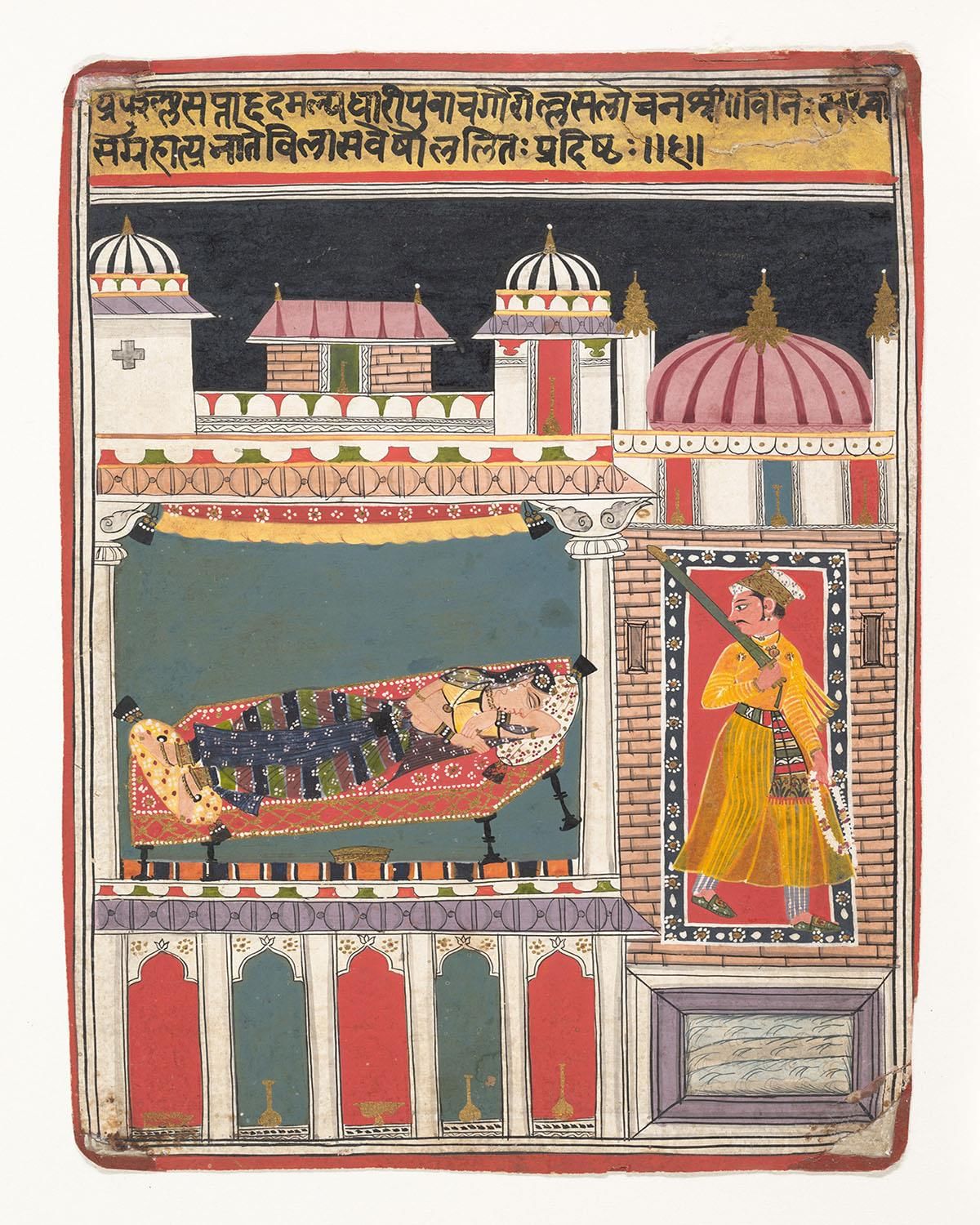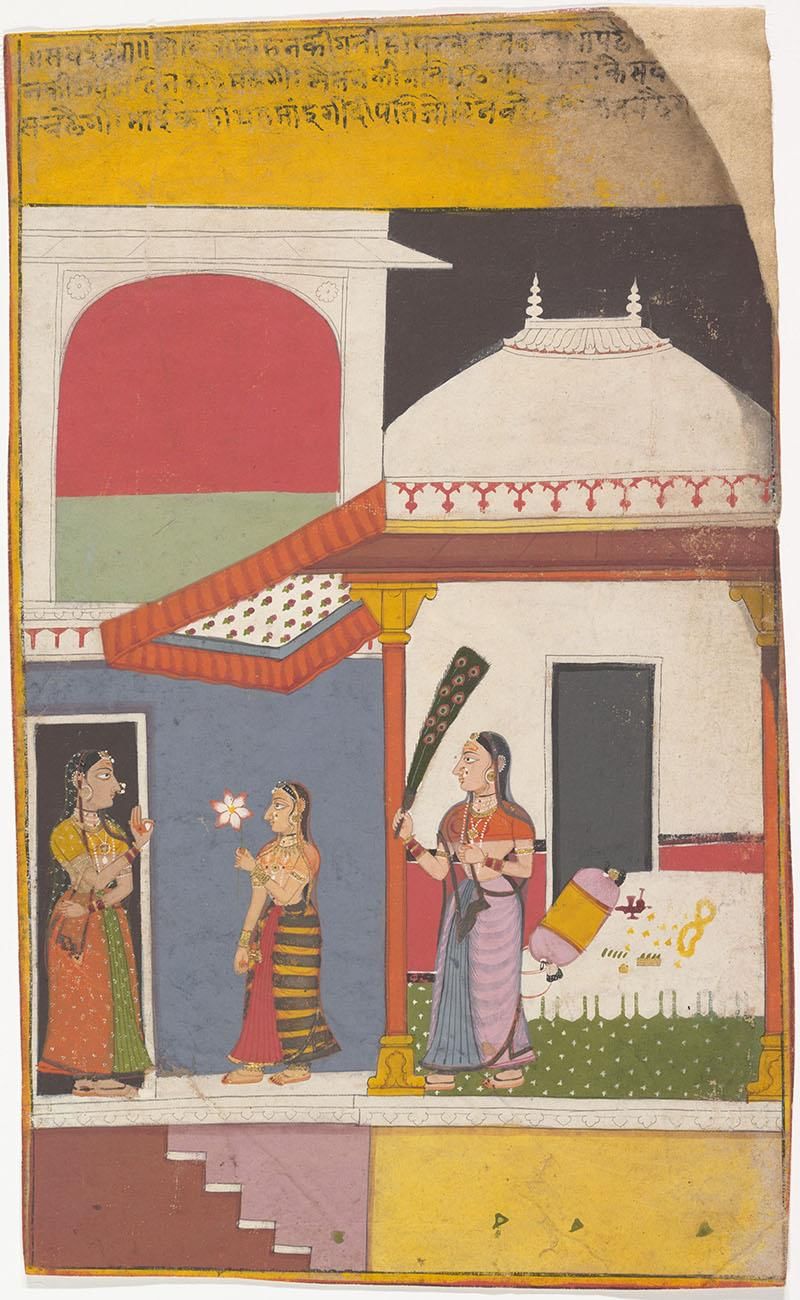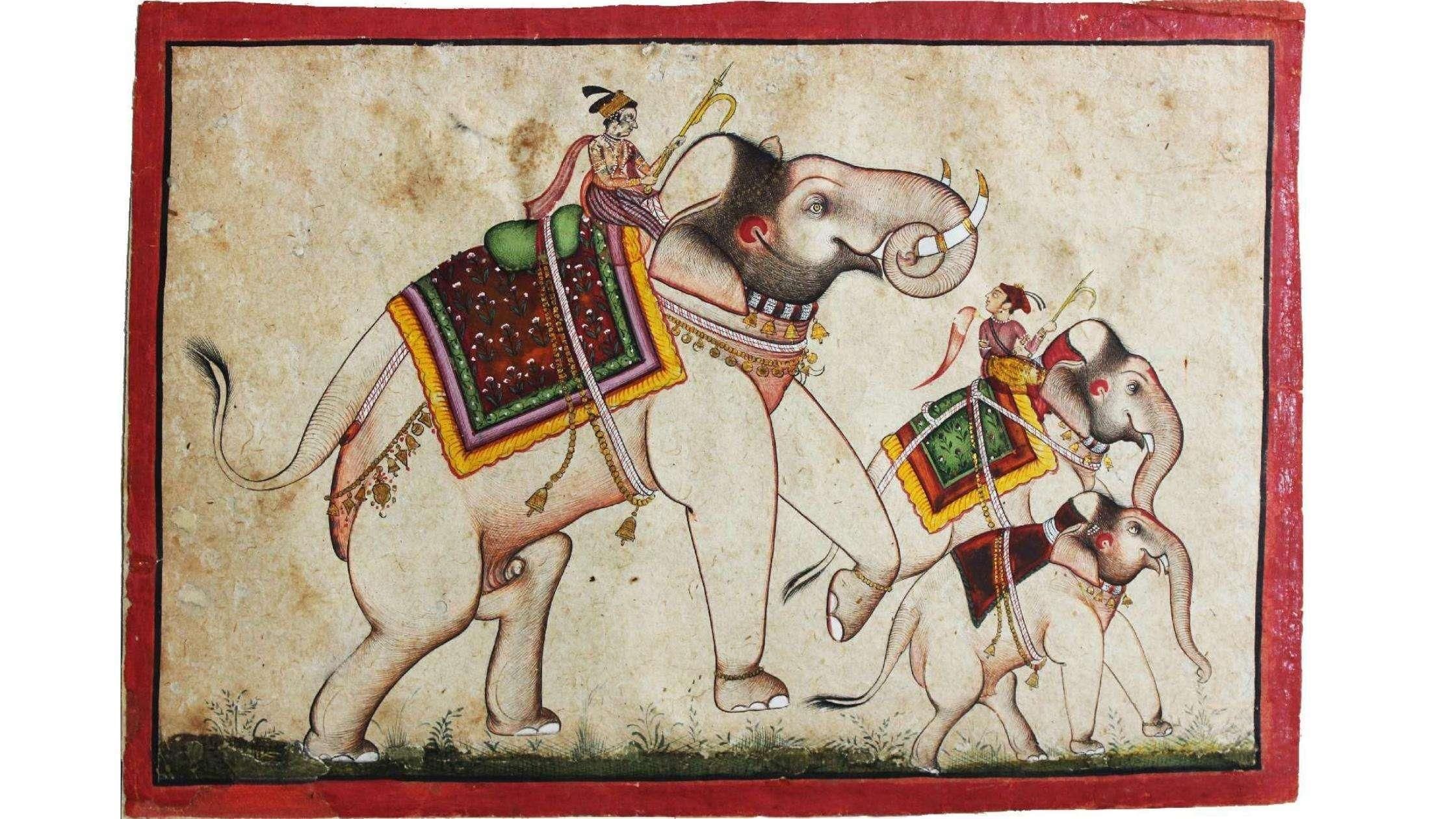The Rajasthani Schools of Painting Chapter Notes | Fine Art for Class 12 - Humanities/Arts PDF Download
The Rajasthani Schools of Painting
The term 'Rajasthani Schools of Painting' refers to the various painting styles that existed in the princely kingdoms and thikanas of what is now Rajasthan and parts of Madhya Pradesh between the 16th and early 19th centuries.

- Scholar Anand Coomaraswamy in 1916 introduced the term 'Rajput Paintings' to distinguish these schools from the Mughal School of Painting, as most rulers and patrons in these regions were Rajputs.
- The scope of Rajput Schools extended to Malwa in Central India and the Pahari Schools in the Himalayan region of north-western India.
- These schools represent the indigenous painting traditions that thrived before the Mughal conquest.
Diversity in Painting Styles:
- Pictorial styles in these kingdoms varied significantly in terms of execution, color preferences, compositional elements, modes of narration, naturalistic depictions, and mannerisms.
- Styles ranged from fine to bold execution, brilliant to gentle colors, and diverse approaches to depicting architecture, figures, nature, and storytelling.
Materials and Techniques:
- Paintings were created on waslis, thin sheets of handmade paper glued together for desired thickness.
- Outlines were drawn in black or brown, with colors applied using mineral pigments mixed with glue.
- Brushes were made from camel and squirrel hair.
- Finishing touches involved burnishing with an agate to achieve a uniform sheen.
Collaborative Process:
- Painting was a collaborative effort, with the master artist sketching and providing initial drawings.
- Specialists in coloring, portraiture, architecture, landscape, and animals contributed their expertise.
- The scribe would write verses in designated spaces within the paintings.
Themes of Paintings - An Overview
- Vaishnavism Influence: By the 16th century, Vaishnavism centered around Rama and Krishna gained popularity in western, northern, and central India during the Bhakti movement.
- Krishna's Appeal: Krishna was not only worshipped as a deity but also as an ideal lover, symbolizing a blend of sensuousness and mysticism.
- Love as a Religious Theme: The concept of love was highly valued in a religious context, especially in depictions like Krishna with gopis in the forest.
- Gita Govinda: A lyrical poem by Jayadeva in the 12th century, portraying the mystical love between Radha and Krishna through vivid imageries.
- Rasamanjari: Composed by Bhanu Datta in the 14th century, a text focusing on the classification of heroes and heroines based on age, appearance, and emotional states.
- Rasikapriya: A work by Keshav Das in the late 16th century, delving into emotive states like love, jealousy, and anger through the characters of Radha and Krishna.
- Kavipriya: Another work by Keshav Das honoring a courtesan, exploring themes of love and the description of the 12 months of the year.
- Bihari Satsai: Authored by Bihari Lal, a collection of verses offering moral insights and witticisms, likely composed around 1662.
- Ragamala Paintings: Visual interpretations of ragas and raginis, associated with specific moods, times, and seasons, organized in albums with male ragas and female raginis.
- Favorite Themes: Depictions from bardic legends, romantic tales, and texts like the Ramayana and Mahabharata were common across various painting schools.
- Diverse Subjects: Paintings captured a wide array of scenes including darbar events, hunting expeditions, festivals, portraits, city views, and more.
Malwa School of Painting
- Flourished Period: The Malwa School thrived between 1600 and 1700 CE.
 Malwa School of Painting
Malwa School of Painting
- Characteristics: Represents Hindu Rajput courts with a simplistic two-dimensional style.
- Influences: Progression from Jain manuscripts to Chaurpanchashika manuscript paintings.
- Origins: Originated in Central India, with mentions of places like Mandu, Nusratgarh, and Narsyang Sahar.
- Notable Works: Includes an illustrated poetic text of Amaru Shataka (1652 CE) and a Ragamala painting by Madho Das (1680 CE).
- Patronage: Likely bought by Datia rulers from travelling artists, featuring themes like Ramayana, Bhagvata Purana, and more.
Other Indian Art Schools
- Mughal School: Dominated from the 16th century in major centers like Delhi, Agra, Fatehpur Sikri, and Lahore.
- Provincial Mughal Schools: Flourished under Mughal-appointed governors, blending Mughal and local elements.
- Deccani School: Thrived in Ahmednagar, Bijapur, Golconda, and Hyderabad from the 16th century.
- Rajasthani Schools: Prominent from the late 16th century, featuring diverse regional styles.
- Pahari School: Emerged in the late 17th and early 18th centuries as an offshoot of the Rajasthani tradition.
Mewar School of Painting
- Mewar Origins: Mewar is thought to be an important early hub of painting in Rajasthan, possibly establishing a continuous stylistic tradition from bold indigenous styles to refined ones post Karan Singh's interaction with the Mughals.
 Mewar School of Painting
Mewar School of Painting
- Early Examples: Many early instances were lost due to prolonged conflicts with the Mughals, but the emergence of the Mewar School is commonly linked to a set of Ragamala paintings from 1605 at Chawand by artist Nisardin.
- Evolution of Style: During Jagat Singh I's reign (1628–1652), artists like Sahibdin and Manohar redefined Mewar painting aesthetics, infusing new life into the style. Sahibdin's works include Ragamala, Rasikapriya, Bhagvata Purana, and the Yuddha Kanda of Ramayana. Manohar's notable piece is the Bal Kanda of Ramayana.
- Later Developments: Jagannath contributed the Bihari Satsai in 1719, while texts like Harivamsha and Sursagar were also illustrated in the late 17th century.
- Unique Techniques: Sahibdin's Yuddha Kanda of Ramayana (1652) introduced novel pictorial elements like oblique aerial perspective, enhancing the scale of war depictions. The art in the 18th century shifted towards courtly themes and activities.
- Color Palette: Mewar artists in the 18th century preferred bright colors, especially reds and yellows, moving away from textual representations to focus on courtly life.
Impact on Mewar Painting
- Secular Shift: Mewar painting in the 18th century transitioned towards secular and courtly themes, featuring portraiture, court scenes, hunting expeditions, festivals, and more.
- Nathdwara Influence: Nathdwara, a center near Udaipur, also became a painting school in the late 17th century, known for large backdrops called pichhwais created for the deity Shrinathji during festivals.
- Artistic Themes: The artwork increasingly depicted courtly life, including scenes of hawking, countryside tours, and varied activities favored by the royals.
Bundi School of Painting
Origin: Flourished in Bundi in the 17th century.
Characteristics: Noted for unblemished color sense and excellent formal design.
 Bundi School of Painting
Bundi School of Painting
Early Phases: Bundi Ragamala dated 1591, painted during the reign of Bhoj Singh (1585–1607).
Patronage:
- Blossomed under Rao Chattar Sal (1631–1659) and his son Rao Bhao Singh (1659–1682).
- Development continued under Aniruddha Singh (1682–1702) and Budh Singh.
Expansion:
- Under Umed Singh (1749–1771), the art reached a refined phase.
- Bundi paintings in the 18th century showed influence from Deccani aesthetics.
Later Phases:
- Bishen Singh (1771–1821) and Ram Singh (1821–1889) further enriched the art.
- Distinct features included lush vegetation, wildlife depictions, and equestrian portraits.
Artistic Details:
- Distinct standards of feminine beauty in Bundi paintings.
- Artists like Shaykh Hasan, Shaykh Ali, and Shaykh Hatim mentioned in works.
Themes:
- Raga Dipak depicted in a night setting with innovative lamp holders.
- Baramasa, a popular theme, provides atmospheric descriptions of the 12 months.
Kota School of Painting
The Kota School of Painting emerged from the rich artistic tradition of Bundi, forming one of the most notable Rajasthani painting schools. This school particularly excels in portraying hunting scenes, reflecting a profound enthusiasm and focus on animal pursuits.
- Historical Background: Bundi and Kota were once part of the same realm until 1625 when Jahangir divided the Bundi empire. A portion was granted to Madhu Singh for his valor in defending against Prince Khurram's rebellion.
- Origins of Kota School: Following its separation from Bundi, the Kota School of Painting began around the 1660s during Jagat Singh's reign (1658-1683). Initially, Kota paintings closely resembled those of Bundi, with Kota artists borrowing heavily from Bundi's styles and compositions.
- Distinctive Features: Over time, Kota artists developed a unique style characterized by non-conformity, exaggerations in figures and architecture, and a strong emphasis on drawing skills. By the reign of Ram Singh I (1686-1708), Kota painting had evolved into a distinct and individualistic form.
- Evolution of Themes: Under Umed Singh (1770-1819), Kota painting expanded to encompass a wide array of subjects. The artists were among the first to prominently feature landscapes as the primary focus of their compositions.
- Focus on Wildlife and Hunting: Umed Singh's reign was marked by a deep interest in hunting and wildlife. The paintings from this period served as visual tributes to his hunting expeditions, reflecting a societal fascination with the chase that even involved court women.
- Artistic Characteristics: Kota paintings are known for their spontaneity, calligraphic execution, and a focus on detailed shading, particularly in the depiction of eyes. Artists from the Kota School excelled in portraying animals and combat scenes.
Bikaner School of Painting
Bikaner School of Painting was established by Rao Bika Rathore in 1488 in Bikaner, Rajasthan.
- Origins: Rao Bika Rathore founded the kingdom of Bikaner, where Anup Singh set up a library that housed manuscripts and artworks.
- Influences: The school's style was influenced by Mughal art, displaying elegance and a subdued color palette.
- Master Artists: Master painters like Ruknuddin, Ibrahim, Nathu, Sahibdin, and Isa contributed to the school's development.
- Studios: Artists worked in studios called Mandis under a master artist's supervision, showcasing a collaborative environment.
- Artistic Practices: The school had a unique practice of inscribing the master artist's name on paintings, even those of their pupils.
- Documentation: Bikaner School is well-documented through royal diaries, inscriptions, and portraits of artists, providing insights into their works and lineage.
The Bikaner School of Painting stands out for its distinctive style, blending indigenous and Mughal influences, and its emphasis on detailed documentation of artistic works.
Kishangarh School of Painting
Overview: Kishangarh paintings are revered for their stylized nature within the realm of Rajasthani miniatures.
Facial Characteristics: Noteworthy for arched eyebrows, lotus petal-shaped pink-tinted eyes, drooping eyelids, sharp slender noses, and thin lips.
Historical Background:
- Founding: Kishan Singh established the Kishangarh state in 1609.
- Patronage: By the mid-17th century, under Man Singh (1658–1706), artists were already active in the Kishangarh court.
- Evolution: The art style evolved to elongate human forms, utilize green tones, and showcase expansive landscapes by the early 18th century during Raj Singh's reign (1706–1748).
Influence of Pushtimargiya Cult: Raj Singh's affiliation with Vallabhacharya’s cult led to a focus on Krishna Lila themes in Kishangarh's art.
Notable Artist:
- Nihal Chand: Renowned painter who worked for Sawant Singh from 1735 to 1757, depicting Radha and Krishna in courtly settings within vast, detailed landscapes.
Artistic Style:
- Color Palette: Kishangarh artists excelled in portraying landscapes with vivid colors and vast vistas.
Jodhpur School of Painting
Jodhpur School of Painting: The influence of Mughal aesthetics in the sixteenth century impacted the style of portraiture and court scenes. Despite this, the indigenous folkish style remained prevalent and resistant.
- Ragamala Set by Virji (1623): One of the earliest sets of paintings in Pali.
- Maharaja Jaswant Singh (1638–1678): Initiated a productive painting era, focusing on documentary painting through portraiture and court life depiction.
- Ajit Singh (1679–1724): Succeeded Jaswant Singh after a 25-year war with Aurangzeb, with legendary warrior Veer Durgadas Rathore playing a significant role.
- Man Singh (1803–1843): Oversaw an innovative phase in Jodhpur painting, including notable sets like Ramayana, Dhola-Maru, Panchatantra, and Shiva Purana.
- Depiction of Local Life: Artists incorporated local architectural, costume, and cultural elements into their paintings, providing insights into the daily life of Jodhpur.
- Nath Sampradaya Influence: Man Singh, a follower of the Nath Sampradaya, was depicted in paintings alongside Nath gurus.
- Inscriptions: Paintings lacked detailed inscriptions until the nineteenth century, with rare mentions of dates, artists, and locations.
|
13 videos|16 docs|16 tests
|
FAQs on The Rajasthani Schools of Painting Chapter Notes - Fine Art for Class 12 - Humanities/Arts
| 1. What are the main themes depicted in the Rajasthani Schools of Painting? |  |
| 2. How many different schools of painting are included in the Rajasthani Schools of Painting? |  |
| 3. What distinguishes the Malwa School of Painting from other Rajasthani Schools of Painting? |  |
| 4. What are some key features of the Mewar School of Painting? |  |
| 5. How does the Kota School of Painting differ from the other Rajasthani Schools of Painting? |  |

















